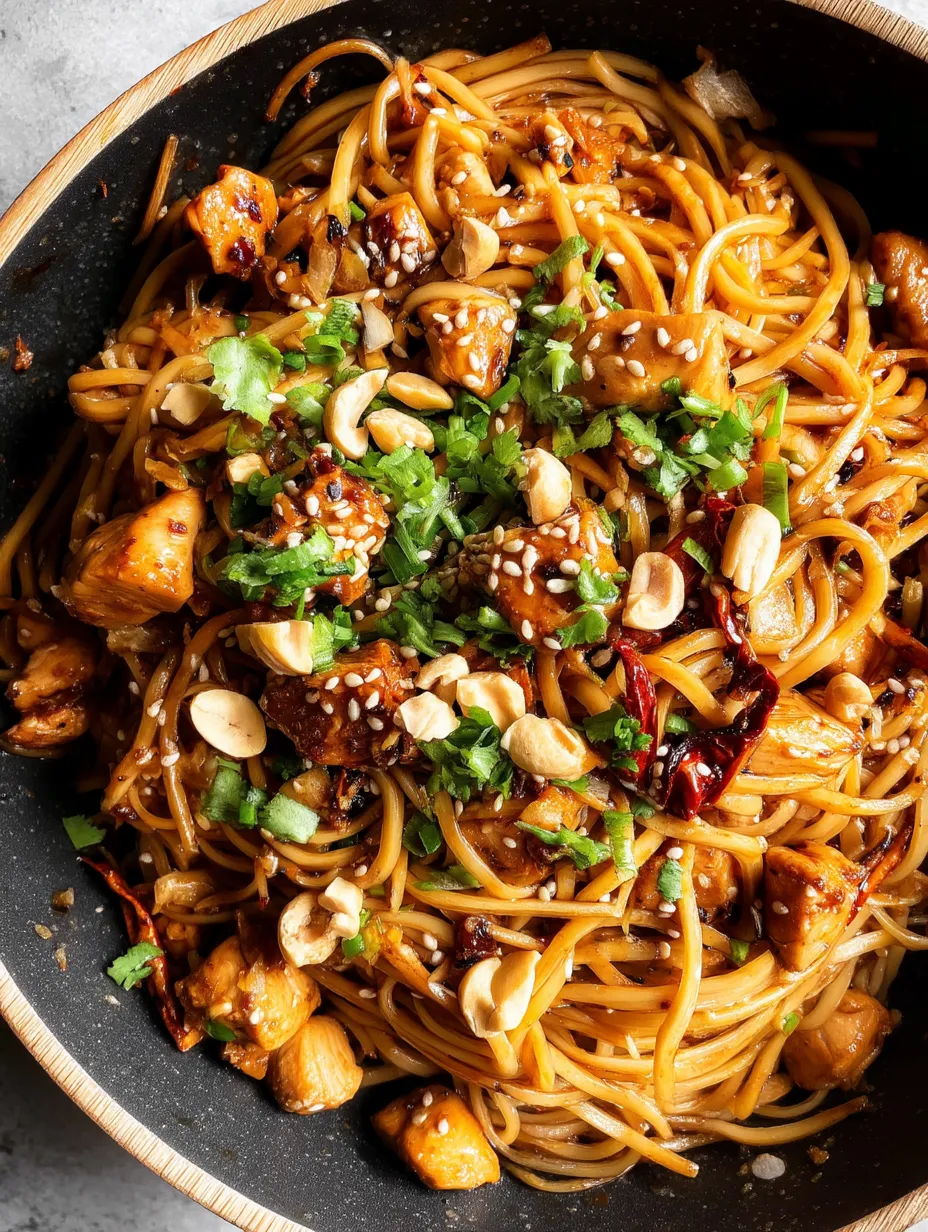 Save
Save
This hearty Kung Pao chicken noodles recipe has become my weeknight dinner savior when I need something flavorful and satisfying without spending hours in the kitchen. The perfect balance of spicy, sweet, and savory flavors wrapped around tender chicken and noodles creates a dish that satisfies those takeout cravings right at home.
I first created this recipe when my family was craving Chinese takeout but our budget was tight that week. The first time I served it, my kids immediately requested it be added to our regular dinner rotation, and it has been a staple ever since.
Ingredients
- Base/Chicken:
- 12 oz noodles of choice: provides the perfect base for soaking up the delicious sauce
- 1 lb chicken breast: lean protein that stays tender when cooked properly
- 2 tbsp low sodium tamari: gives umami depth without making the dish too salty
- 1 tbsp honey: adds just enough sweetness to balance the heat
- 1 tbsp chili paste: brings that signature Kung Pao heat
- 1 tbsp toasted sesame oil: adds nutty richness that regular oils cannot provide
- ½ cup diced green onions: mostly white parts adds aromatic flavor to the base
- 1 tbsp minced garlic: essential for authentic Asian flavor profiles
- Sauce:
- ½ cup low sodium tamari: forms the savory foundation of our sauce
- 1 tbsp peanut butter: creates creaminess and authentic nutty flavor
- 2 tbsp rice vinegar: provides essential acidity that brightens all flavors
- 2 tbsp chili paste: delivers the characteristic Kung Pao heat
- 1 ½ tbsp brown sugar: balances the spice with caramelized sweetness
- ¼ tsp ground ginger: adds warmth and complexity to the sauce
- 1 ½ tablespoons toasted sesame oil: rounds out the sauce with earthy notes
- ½ tsp red pepper flakes: builds additional layers of heat
- 3 tbsp water: thins the sauce to perfect consistency
- 1 tbsp cornstarch: creates the ideal thickness that clings to noodles and chicken
- For Garnish:
- ⅓ cup crushed peanuts: adds traditional crunch and texture contrast
- ⅓ cup diced green onions: mostly green parts brings fresh flavor and color
Step-by-Step Instructions
- Prepare the Sauce:
- Combine all sauce ingredients in a medium bowl and whisk thoroughly until completely smooth. Focus on dissolving the cornstarch entirely to prevent lumps in your finished sauce. The sauce should have a rich reddish brown color and slightly thick consistency.
- Marinate the Chicken:
- Cut chicken breast into bite sized pieces about 1 inch in size. In a bowl, combine the chicken with tamari, honey, chili paste, and sesame oil. Allow to marinate for at least 5 minutes while you prepare other ingredients. This quick marinade infuses the chicken with flavor before cooking.
- Cook the Noodles:
- Bring a large pot of water to a rolling boil and cook noodles according to package directions. For the best texture, cook the noodles until just al dente as they will continue cooking slightly when combined with the hot sauce. Drain thoroughly and set aside.
- Cook the Chicken:
- Heat a large skillet or wok over medium high heat. Add a tablespoon of cooking oil and when shimmering, add the marinated chicken in a single layer. Cook for 3 to 4 minutes per side until golden brown and cooked through. The chicken should reach 165°F internally and have a lovely caramelization.
- Build the Flavor Base:
- Add the diced white parts of green onions and minced garlic to the cooked chicken. Stir constantly for about 30 seconds until fragrant but not browned. The aromatics will release their flavors into the oil and chicken, creating the foundation of your dish.
- Combine Everything:
- Pour the prepared sauce into the skillet with the chicken and bring to a simmer. The sauce will begin to thicken almost immediately due to the cornstarch. Add the cooked noodles to the skillet and toss thoroughly until every strand is coated with the glossy sauce and heated through.
- Garnish and Serve:
- Transfer to serving plates or a large platter and top with crushed peanuts and green onion tops. Serve immediately while hot and the sauce is at its perfect consistency.
 Save
Save
My secret ingredient is definitely the peanut butter in the sauce. I discovered this addition after trying to recreate my favorite restaurant version, and it adds a creamy richness that transforms the dish from good to absolutely craveable. My husband now judges all restaurant Kung Pao dishes against my homemade version!
Noodle Options
While this recipe works beautifully with any noodles you have on hand, each type offers something special. Rice noodles keep the dish gluten free and have a delicate texture. Ramen or egg noodles provide a heartier chew that stands up well to the robust sauce. Soba noodles add a nutty flavor that complements the peanuts. Even spaghetti works in a pinch! Cook your noodles just slightly underdone as they'll continue to absorb sauce when combined.
Make It Your Own
This recipe is incredibly adaptable to various dietary needs and preferences. For a vegetarian version, substitute the chicken with firm tofu pressed and cubed or a mix of mushrooms for meaty texture. If peanut allergies are a concern, use sunflower butter instead of peanut butter and substitute the crushed peanuts with toasted sesame seeds. For a lower carb option, reduce the noodles by half and add spiralized zucchini or carrots to bulk up the dish with vegetables.
Spice Level Management
Kung Pao dishes are traditionally spicy, but you can easily adjust the heat level. For a milder version that's kid friendly, reduce the chili paste to 1 tablespoon and omit the red pepper flakes entirely. If you're a heat lover, add 1 to 2 thinly sliced fresh Thai chilies when cooking the garlic and green onions. Remember that the spice level will intensify slightly as leftovers sit overnight, so keep that in mind when seasoning.
Storage and Meal Prep
These noodles make excellent meal prep or leftovers. Store in airtight containers in the refrigerator for up to 4 days. The flavors actually develop and improve overnight! When reheating, add a splash of water or chicken broth to loosen the sauce as the noodles will have absorbed some of the liquid. For the best texture, reheat in a skillet over medium heat rather than the microwave. The dish can also be frozen for up to 2 months, though the texture of the noodles may change slightly upon thawing.
Frequently Asked Questions About Recipes
- → Can I use a different protein for this dish?
Yes, you can substitute the chicken with tofu, shrimp, or beef for a different take on this dish.
- → What type of noodles work best?
Any type of noodles can work, such as rice noodles, egg noodles, or even spaghetti. Choose your favorite!
- → How can I adjust the spice level?
To reduce the spice, omit or decrease the chili paste and red pepper flakes. For more heat, increase these ingredients to taste.
- → Can I make this dish gluten-free?
Yes, use gluten-free tamari and ensure all other ingredients are gluten-free, including the noodles.
- → What can I use as a garnish instead of peanuts?
If you’re allergic to nuts, try garnishing with toasted sesame seeds, crispy shallots, or additional green onions for a nice finishing touch.
